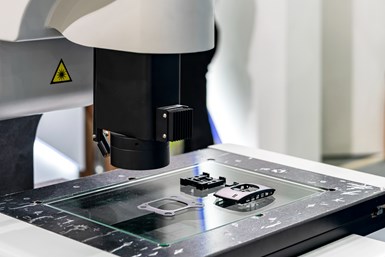The Trend Revolutionizing Machining
Advancements in machine vision technology are advancing at warp speed and machining company leaders may do well to consider this key trend in the world of industrial automation and advanced manufacturing.
When the TechEd Podcast visited recently with 22 industry leaders at an international automation conference, each was asked to share one key trend in the world of industrial automation and advanced manufacturing. It was not surprising that artificial intelligence (AI) rose to the top of the list for most of these experts, but a close second was advancements in machine vision.
Note that the trend we heard wasn’t machine vision itself. This technology has roots going back nearly 100 years and the basics of machine vision systems haven’t changed significantly in the last decades. The game changer to which these experts were referring is advancements in machine vision, including rapid improvement in camera technology; high-speed, event-based sensors that detect variations in brightness; and powerful AI and machine learning innovation. Together, these are having a multiplier effect on the precision, speed, applications and benefits of machine vision technology.
For the uninitiated, a machine vision system combines myriad technologies, including illumination or lighting tools, a camera and (usually, but not always) a lens that together acquire images. The images are then processed either at the edge by the camera itself or transferred to a separate processor that processes the image, interprets the data and elicits a corresponding output or action.
For a simple example, consider dimensional measurement on a production part. The camera generates an image that is interpreted for the part’s dimensions and compared to specification tolerances for conformance or nonconformance. Conforming parts are accepted and passed to the next operation while nonconforming parts are rejected for rework or scrap. Measuring dimensional conformance is one example, but the applications for machine vision capability in advanced manufacturing go much further.
On offer at the same conference were products from several autonomous mobile robot (AMR) companies. Unlike their line-following automated guided vehicle predecessors, these “driverless fork trucks” use machine vision technology and machine learning to map the entire manufacturing floor to efficiently move loads from point to point with zero human interaction.
Using what is commonly referred to as 3D imaging, advancements in machine vision now enable robots to perform random bin picking, meaning a robot can find a part in a container, discern its shape, size and orientation, then grip it, move it and place it in a machine or on a rack and do so completely autonomously.
As shared by one guest on the TechEd Podcast, machine vision and related technology have even advanced to the point where robots can align and orient a wheel, and place it on the lugs connected to the vehicle’s axle while the lugs are moving down an assembly line.
Machine vision advancements like these will revolutionize contract machining as robots can be leveraged to perform machine tending operations in low-volume/high-mix environments that were previously beyond the capabilities of traditional automation technology.
The most fascinating advancements in machine vision technology are resulting from the emergence of the most significant trend identified by our experts — AI and its subcategory machine learning. Consider the wide range of use cases for machine learning technology, including dimensional measurement, edge detection, color analysis, serial number tracking, part posture and motion, and the presence of contaminants, just to name a few. Using this data, a machine learning platform can be trained to identify nonconformances and contain quality issues in real time.
Going one step further, as this data is gathered over time, a machine learning platform can be put to use to not only find patterns and outliers in each data set individually (edge detection, for example) but patterns between individual data sets. For instance, an outlier generating a dimensional nonconformity may point to a root cause represented in the data gathered by a temperature sensor. In minutes, machine learning technology could be used to identify the causal relationship in a way that may have taken traditional human troubleshooting methods days or weeks.
Such is the pathway of advanced manufacturing and machining company leaders will do well to take notice. These are not pie-in-the-sky dreams about the future of advanced manufacturing. They are the reality of today’s most fascinating manufacturing processes, all thanks to machine vision technology advancing at warp speed.
Related Content
Unattended Production Takes More Than the Most Capable CNC Machine
Process planning and reliable peripherals are key to successful lights-out manufacturing.
Read MoreChuck Jaws Achieve 77% Weight Reduction Through 3D Printing
Alpha Precision Group (APG) has developed an innovative workholding design for faster spindle speeds through sinter-based additive manufacturing.
Read MoreJob Shop Discovers and Fills a Fishing Need
The promise of a product line for improved mounting of electronic fish finders led this Missouri job shop to an automated turning process.
Read MoreReinventing the Wheel with Robot-Automated CNC Multitasking
One race team discovers how to efficiently manufacture a new wheel nut design for the next-generation NASCAR stock car with the help of a CNC mill/turn and a built-in robot.
Read MoreRead Next
Do You Have Single Points of Failure?
Plans need to be in place before a catastrophic event occurs.
Read MoreSeeing Automated Workpiece Measurement in Real Time
User-friendly inspection software for CNC machining centers was shown at IMTS 2024 monitoring measurements between and after machining while performing SPC based on recorded measurement values.
Read MoreA Tooling Workshop Worth a Visit
Marubeni Citizen-Cincom’s tooling and accessory workshop offers a chance to learn more about ancillary devices that can boost machining efficiency and capability.
Read More













.jpg;maxWidth=300;quality=90)









